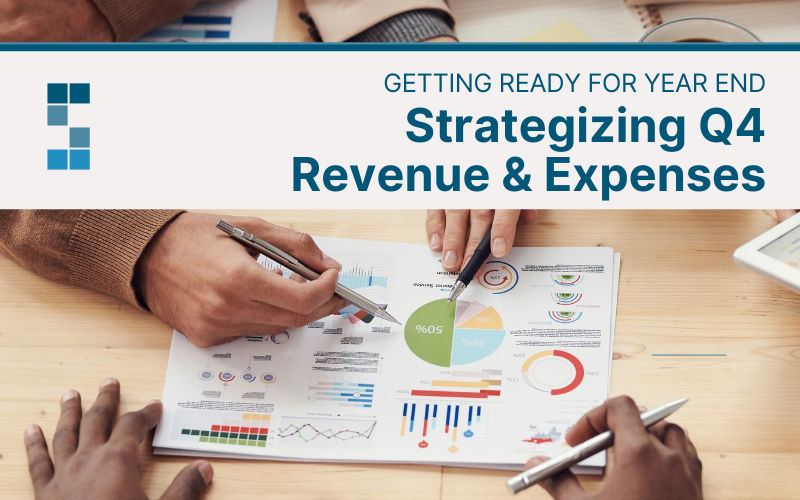
by Dev | Dec 14, 2021 | Blog
It’s a fact that close to a third of annual charitable giving happens in December and that nearly 12% of all giving happens in the last three days of the year.
(Source: neonone.com.)
December is THE month for charitable giving. As we enter the height of the holiday season, now is the time to create a plan for how your business will give back.
Why should charitable giving be a priority as your organization or business prepares for the year’s end? Here are a few considerations as you plan to give charitably this holiday season.
Tax Benefits
It might seem like a self-serving motivation for giving back, but the truth is that tax deductions are a huge incentive for businesses to give charitably.
You may not know that not all donations to nonprofit organizations and charities are eligible as deductions. To claim a charitable deduction, you must give to a qualified charity. Handily, the IRS has an online search engine specifically for checking this.
If claiming a charitable deduction is crucial to you as you donate this year, make sure to research your nonprofit of choice to ensure they meet the IRS’ requirements to be a qualified charity. Meanwhile, make sure you read and understand the IRS’ specific rules concerning charitable deductions.
Don’t forget that qualified donations dated before the end of this year still count for a deduction, even if the funds aren’t scheduled to be released until the new year!
Research, Research, Research
It’s important that you do ample research on any organization you plan to support to ensure alignment with your business’ values.
We recommend researching further than just reading an organization’s mission statement or articles about its activity. It has, unfortunately, become much too easy these days for scammers to hide behind professional-looking marketing and websites. Protect your reputation and your financial contributions, and dig deep into the values and history of the nonprofits you would like to support.
There are specific organizations that can help you do just that. Websites like GiveWell and Charity Navigator keep track of and even rank nonprofits and charities based on factors like transparency and accountability.
Connecting Meaning To Your Work
It might sound cliche, but there is solid evidence to show that giving usually benefits the giver more than the recipient.
As Simon Sinek said, “When we help ourselves, we find moments of happiness. When we help others, we find lasting fulfillment.”
Don’t underestimate the value that charitable giving can give your business and the people who work for you. Giving back is a way for you and your employees to feel connected to something meaningful. This can enrich your work environment and give those who work for you another way to feel invested in your organization and the work you do.
It’s especially true when you choose to give back to organizations doing good work within your own community. When you’ve established a giving relationship with local charities and nonprofits, it can be enormously fulfilling to see your business’ contributions at work for good within your neighborhood.
Whether your business chooses to partner with a global nonprofit or a small, local charity this season, giving back is a value worth prioritizing.

by Dev | Dec 9, 2021 | Blog, Bookkeeping Best Practices
A good fourth quarter just might be the most important win of your business year, because it demonstrates that you know how to implement the right strategies to succeed when and where it counts.
Reviewing this year’s financial records, as well as the goals you made at the start of the year, is a great place to begin gathering the information you need to build the right strategy for the end of the fourth quarter.
Do you hope to show profitability or growth? Do you have investors or stakeholders who are expecting you to hit certain metrics? Did you have a challenging first quarter and do you want to balance it with a big final quarter, or do you want to save those sales for a strong Q1 in 2022? What insights can you pull out of the past year to strategize setting new goals next year? Depending on your situation, here are our tips for making the most of your final weeks of the year.
No matter your situation, there are a few things you should double check and remember.
- If you have a single member LLC but have elected as an S corp, make sure to check with your CPA to make sure you have taken the appropriate salary for the year. If not, you can still change your salary over the next few weeks as needed.
- The holidays is a great time to be generous:
- If you are in the position to do, charitable donations can make a big difference in your community, and they will reduce your taxable income, helping reduce the tax bill you’ll have to pay come April
- Also, it can be a great time to be generous with your team. Whether $50 or $500, a holiday bonus can go a long way to keep your team happy, especially critical in this competitive labor market. But, remember, you must record these bonuses or gifts as income as part of your payroll system. Christmas gifts mean withholding taxes for both the employee and employer – so make sure you pay these through your payroll system, and not via cash!
Strategies for when you’re ending the year with strong profits.
So, you’ve had a great year, and your profits reflect it. What strategies can you implement to reduce potential liabilities and secure conservative metrics before the next tax season?
Take the time to go back through your books and make sure you’ve taken advantage of tax-deductible expenses throughout the year. This is where detailed bookkeeping and implementing accounting technology throughout the year will pay off. Make sure you haven’t missed any valuable write-offs!
If you’ve accounted for all your tax write-offs, this may be the perfect time to purchase new equipment or restock inventory. Significant expenses will reduce your overall taxable income for the year, giving you much-needed new equipment or increased inventory, and importantly, relief on your forthcoming tax bill. Don’t buy equipment just to reduce your taxable income, however – these purchases should be purchases you are going to take on, regardless of timing. But, if you are going to spend the money, spending it in December 2021 vs. January 2022 means you’ll help reduce taxes you must pay come April 2022.
On the flip side, if you are experiencing high demand from your customers in this final quarter, can you defer some of that demand into Q1 2022? Having those customers purchase in Q1 2022 will help reduce your 2021 tax liabilities by reducing your income in 2021. Of course, you’ll still pay income tax on those sales, but by having a customer purchase occur in January 2022, vs. December 2021, you don’t owe Federal Income tax until April 2023 for that sale vs. April 2022 if that sale had occurred just a few weeks earlier in December.
Of course, pulling forward expenses and pushing out demand also impacts what your 2021 P&L looks like. So make sure your actions aren’t going to cause you to miss important revenue or profit goals.
Strategies for when you’re ending the year behind in profits.
What if you’ve reached the fourth quarter and your profit/loss balances don’t match the goals you set for your business at the beginning of the year? What strategies can you implement in the remaining weeks of this year to bring your profits up?
Before panicking, start by critically evaluating your annual numbers. How does this year’s fourth-quarter profit and loss statement compare with last year’s? How much more do you need to earn to meet your goals before the new year? Were the goals you set maybe unrealistic?
Once you have concrete numbers to work with, you can strategize ways to bring up your fourth-quarter profits much more efficiently.
Obviously, how you bring up profits at the end of the year will differ widely depending on the type of business you have, but some helpful questions to consider may be:
- Are there unsold customers from earlier in the year you can follow back up with?
- Are there ways to improve or change up your marketing strategies this holiday season? Would a sale drive a big increase in volume?
- Do you have any stock surplus that you can strategically market and sell?
- Are their proposals in the pipeline that you can push through before the end of the year?
Don’t forget to use the information you gather during this time to help you set the appropriate goals for the coming year. Take a moment to recognize sales trends in your industry, particularly if you have historically strong months or quarters. This can help you balance your annual budget and build sales strategies accordingly.
We may only have a handful of weeks left this year, but there are a lot of things you can do in a relatively short amount of time to finish this year well. Do you have questions about getting a fourth-quarter strategy in place? We can help.

by Dev | Nov 24, 2021 | Blog, Bookkeeping Best Practices
Businesses employ independent contractors all the time, in multiple capacities. Perhaps you hired a freelance designer to create marketing materials for your business this year, or maybe you brought in an independent consultant to develop strategies to improve your operations. If you used a contractor or vendor this year and paid them $600 or more, you need to be prepared to issue them a 1099 tax form by January 31.
1099’s can be complicated and confusing, dreaded by employers and contractors alike. Even if you have experience with issuing or filing 1099s, you may have missed recent changes in tax laws that might affect you this year. Unfortunately, the consequences of failing to use 1099s properly can include fines and penalties, so understanding these complexities is essential. Here are some steps and considerations to keep in mind as you, the employer, prepare for the end of the year.
The first step is to figure out which 1099 form your contractor will need. As of 2021, there are 20 varieties of 1099 forms, but the 1099-NEC (non-employment compensation) form and 1099-MISC form historically have been the ones most commonly used for contract employees who were paid $600 or more during the year.
Use the Proper 1099 Form
Why is this important to know? Until 2020, the 1099-MISC form was used to report payments to independent contractors and vendors for services rendered, but differing due dates created loopholes in the system that were being abused. As a result, beginning in 2021, the 1099-NEC was reinstated to report all payments to non-employed individuals. This covers nearly all contract/freelance work, with a few rare exceptions that may still require a 1099-MISC form.
Always consult a tax professional if you have any questions or uncertainties about which 1099 form you need to issue to your particular contractors and vendors.
Accurate Compensation Records
The next step is to ensure you have all the information needed before issuing 1099 forms to your contractors. Some important questions to consider are, do you have an accurate account of which contractors and/or vendors you used this year, and how much you paid each of them? Implementing a system at the beginning of the year to keep an accurate account of who you are contracting and how much you are paying them will keep you organized and on track when it comes time to issue 1099 forms.
Update Contact Information
Do you have up-to-date and accurate ways of contacting them? Sometimes contractors and vendors move locations or change their contact information. Fall is the perfect time to start making sure you have their up-to-date details, so your 1099 forms get to where they need to be on time (keep in mind that January 31 is the deadline for mailing 1099s to most taxpayers.)
This feels like the right time to re-emphasize the importance of implementing a system and process to keep an accurate account of all these details as early as possible. In today’s paperless, digitalized world, we love software like GUSTO that has digital payroll options for managing your contract employees Additionally, we use Track 1099 when it comes time to e-file on behalf of clients. Still, whether you choose to use the latest software or hire outside professional accounting help, the most important thing is that you have a process in place to ensure you don’t forget about your contract employees and vendors.
At System Six, we pride ourselves on staying up to date with the latest tools and technologies to help clients keep their books clean and organized all year long, setting them up for success during tax season and beyond. So, we focused year round on 1099s (collecting vendor information throughout the year, for example), but now that it’s approaching year end, it’s your turn as well to prioritize 1099s!
Does the process of preparing to issue 1099s to your contracted employees confuse or frustrate you? Are you feeling overwhelmed about your 1099s? We’d love to chat. Please reach out.

by Dev | Oct 26, 2021 | Blog
One of our least favorite tasks is having to make changes in our critical professional relationships. Whether it’s shopping around for a new dentist, doctor, or accountant, the search and subsequent transfer of years of paperwork and documentation can be overwhelming.
However, there are numerous reasons why you may find yourself needing a new CPA as your business evolves and grows. While you may not be able to skip the tedious process of shopping for a CPA that meets your unique needs, you can save yourself time and overwhelm by beginning that search early.
Why You Might Need to Switch CPAs
There are multiple reasons why you might change CPAs. How do you know if it’s time for you to begin that search?
You’ve had a bad experience.
CPAs are part of the service industry, and you are the customer. You wouldn’t continue to go to a store or restaurant where the employees mistreated you. If a CPA is rude or inexperienced, you do not have to stay with them.
They can’t answer your questions.
Your CPA should be able to answer any questions you have without making you feel embarrassed or rushed. Look for a patient CPA who invests in helping you understand the whole process. This professional relationship is built on trust. If you are struggling to communicate with and trust your current CPA, it might be a good time to start shopping around for someone who can better meet your needs.
You need a CPA with specific expertise.
If you are in a highly regulated industry, such as insurance, medical services, or newer industries such as cannabis or cryptocurrency, you will need a particular CPA who is experienced and equipped to help you. Most US states have very specific tax codes and regulations at state level, in addition to the millions of rules at the federal level! If your company operates in several states, you need a CPA versed in national tax codes, as well as state laws. Make sure your CPA understands and is prepared to help you navigate these complexities.
They need to be able to grow with you.
Does your CPA use the same technology as you? Do you share visions of innovation? Are they planning on retiring in a year or two? These are all critical questions to consider as you look for the right CPA. It might not be worth starting a new professional relationship with someone on the brink of retirement or with someone who still works with paper-and-pen systems when all your files and data are digital. Keep the big picture in mind as you prepare questions for a prospective new CPA.
When to Secure Your CPA
Unfortunately, if you wait until January or February to secure a new CPA, you may be too late. Many CPA firms book up by January, and by waiting too long, you run the risk that your preferred firms will not have the capacity to serve you in time for the upcoming tax season.
If you need a new tax-preparing CPA, you need to start shopping around in the fall.
Ask for recommendations from respected friends and your professional network (certainly, ask us!). Then follow up with firms individually for a one-on-one meeting. Don’t be afraid to ask questions or present specific scenarios to gauge how well you would collaborate. Starting this process in the fall provides ample time to vet your options and onboard your company before the crunch of tax season.
Switching to a new CPA may feel like a daunting task, but you can set yourself up for success by beginning early and advocating for your company’s needs.

by Dev | Oct 12, 2021 | Blog
Is it just us, or does time seem to accelerate as we move into the fall season? It’s like the time between summer ending and the beginning of the holiday season turns into a busy blur, and before we know it, we find ourselves at the end of the year in a mad rush to get ready for tax season.
Fortunately, we know there are small, practical steps you can start taking this fall to have your business ready for the end of the year, so you don’t find yourself scrambling in January. That’s why for the rest of the year, we’re going to be focusing on “Getting Ready for Year-End,” sharing our most constructive ideas on how you can best support your CPA, bookkeeper, and business before the next tax season.
Separating Personal Expenses
Your greatest priority before the end of the year is to have clean books by January before processing documents for taxes. Separating your personal expenses from business expenses is a great place to begin, as it can be a time-consuming job – especially if you get a late start!
Many business owners have separate cards for their business and personal expenses, but sometimes the wrong card gets used. Sometimes larger personal purchases are put on the business card because it’s the one that gives back the most points or discounts with certain vendors. These switch-ups may not happen frequently, but that makes them easy to miss or lose track of.
Where to Begin
As you go through your books to separate the personal expenses from the business expenses, start large and work towards small. Identify the substantial expenses first, like travel and purchases of equipment or assets. Once those are appropriately categorized, move on to the smaller expenses, like meals and office supplies. Just like breaking household chores down room by room makes the work seem less overwhelming, breaking up this expense categorization into different sections makes a potentially overwhelming task much more manageable.
Home Office Deductions
If you are one of many business owners working out of a home office, you can deduct a percentage of your home utilities based on the square footage of your office compared to your house. This is another tedious task that can be easy to forget until your CPA is asking for the numbers in the middle of tax season. As you sort out your personal expenses, take the time now to figure out these square footage percentages before the end of the year. Your CPA or bookkeeper will thank you!
The best way to ensure you don’t miss essential deductions, big or small, is to make personal expenses clean up a monthly rhythm. Much like the dust piles up when you let too much time pass between sweeping your house, your books get “muddier” and more confusing the longer you let them pile up without separating them. Unfortunately, the muddier the books get, the greater the chance is that you’re going to make a costly error.
At the very least, we recommend making a fall month like October your yearly reminder to comb through your books. Avoiding the mistake of waiting until January will save you time, peace of mind and ultimately, dollars.





